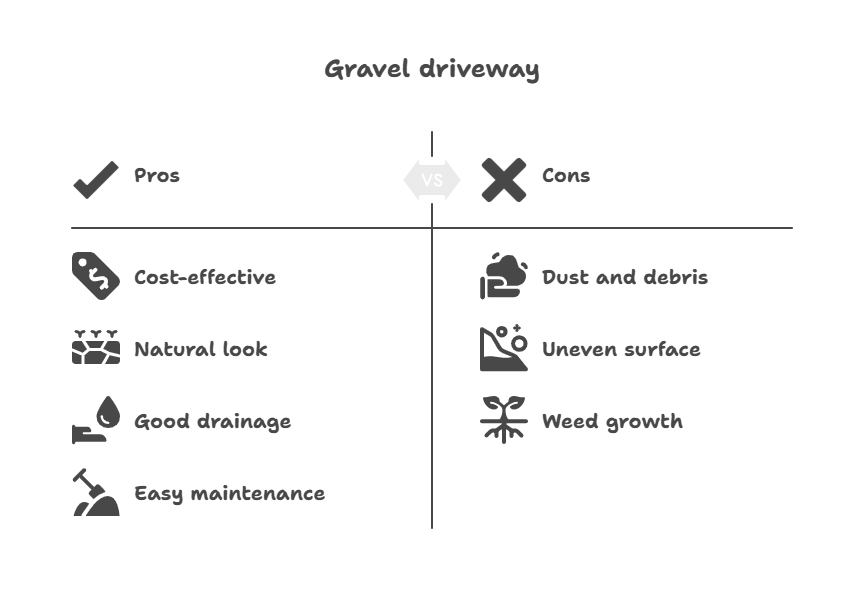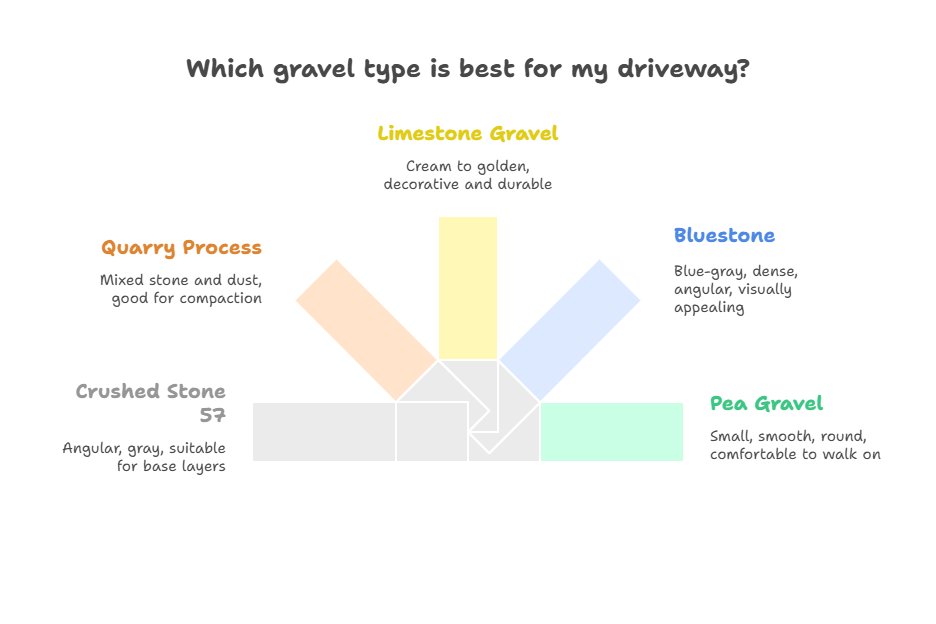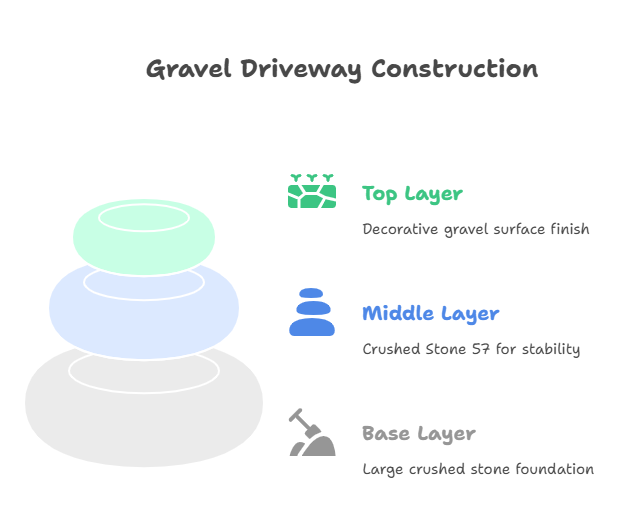Choosing the best gravel for your driveway is important for creating a strong, attractive surface that lasts. Gravel size, type, and installation affect how well your driveway handles traffic, drainage, and maintenance over time. This article explains how to select the right gravel, how to install it correctly, and how to keep your driveway in great shape for years.
Why Gravel Size and Type Are Crucial for Driveway Success
The size and shape of gravel directly impact your driveway’s durability and usability. Stones that are too small can get stuck in tires and shift often, causing an uneven surface. Large stones, over 1.5 inches, make walking and driving uncomfortable and don’t compact well.

Most experts recommend gravel between three-quarters of an inch and one inch. This size offers a stable, well-draining surface. The shape matters too. Angular crushed stone locks together because of sharp edges, reducing shifting and ruts. Round stones like pea gravel look nice but move easily and need edging or grids for stability.
Good drainage is essential. Gravel that lets water pass prevents pooling and erosion. This protects your driveway and saves you money on repairs.
Read More = How Much Is a Yard of Gravel? 2025 Pricing, Costs, and Expert Guide
Common Gravel Types for Driveways and Their Uses
Crushed Stone 57
This stone is hard, angular, and sized from half an inch to one inch. Made from materials like granite or limestone, it compacts tightly and drains water well. It is a favorite for residential and commercial driveways because of its strength and reliability.
Quarry Process (Crusher Run)
Quarry process mixes crushed stone with stone dust, creating a compactable base. It’s affordable and forms a dense foundation, especially good for driveways with heavy vehicles or trucks.
Limestone Gravel
Known for natural cream and golden colors, limestone provides good drainage and adds curb appeal. It is best in dry or temperate climates as it may move in freeze-thaw conditions due to its softer nature.
Bluestone
Bluestone offers a strong and visually pleasing blue-gray surface. Its density adds durability, while its angular shape helps with compaction. Bluestone is popular in certain regions and lasts a long time with proper care.

Choosing Gravel Colors for Style and Practicality
Neutral gravel colors like gray blend well with many homes and hide dust and tire marks better. Warm tones like golden brown complement traditional brick houses. Light-colored gravels brighten shady areas but show stains quickly. White gravel looks nice but needs regular cleaning. Multicolored blends hide wear and create a natural look that lasts.
Step-by-Step Guide to Building a Gravel Driveway
Building a strong gravel driveway involves layering materials properly.
- Clear and Excavate: Remove grass, roots, and soil to a depth of at least 8 inches. Dig deeper in soft or wet soil areas.
- Base Layer: Lay 4 to 6 inches of large crushed stone (about 1.5 inches). This supports weight and drains water quickly. Compact this layer fully using a plate compactor.
- Middle Layer: Spread 2 to 3 inches of crushed stone 57. This fills gaps, distributes weight, and adds stability. Compact again.
- Surface Layer: Add 1 to 2 inches of decorative gravel. Keep this layer thin to prevent tires from pushing stones aside.
- Add Edging: Use stone, metal, or plastic edging to keep gravel contained and stop it from spreading into gardens or lawns.
- Slope Properly: Grade the driveway with a 2% slope away from buildings to allow water runoff and prevent pooling on the surface.
Read More = How Much Does a Yard of Gravel or Sand Weigh? Complete Weight & Project Planning Guide
Estimating Gravel Driveway Costs
Costs depend on gravel type, driveway size, and installation.
- Quarry process costs roughly twenty to twenty-five dollars per cubic yard.
- Premium stones such as bluestone may cost sixty dollars or more per cubic yard.
- Labor costs range from twenty to seventy dollars per hour for professionals.
- A 600 to 1,000 square foot driveway typically costs one thousand two hundred to four thousand five hundred dollars including materials and installation.
- DIY installation reduces labor expenses but requires tools like compactors and shovels.
- Maintenance expenses run about one hundred to three hundred dollars per year for regrading and adding gravel.

Maintaining a Gravel Driveway
Regular maintenance keeps your driveway smooth and attractive.
- Rake displaced gravel to fill ruts and bare spots.
- Clear leaves and debris frequently to minimize weed growth.
- Apply annual weed control treatments as needed.
- Add fresh gravel every few years, especially to worn or high-traffic areas.
- Keep drainage ditches clear and slopes graded to prevent erosion and puddles.
A well-maintained gravel driveway can last for decades without needing major repairs.
Choosing Gravel by Climate Conditions
- In cold regions, use angular crushed stone that resists frost damage and freeze-thaw movement. Avoid fine gravel that holds moisture.
- Hot areas work best with lighter-colored stones that reflect heat and keep driveways cooler.
- Wet climates require gravel with excellent drainage and possibly French drains or pipes to keep water away from the driveway.
Read More = How Much Sand Do I Need? Accurate Calculations for Every Project
Frequently Asked Questions
Can I use pea gravel for a driveway?
Pea gravel is usable but tends to shift under tire pressure without help. Adding edging and stabilization grids can improve its performance. For heavy vehicles, angular crushed stone offers better support.
What size gravel works best for a driveway?
Gravel sized between three-quarters and one inch is ideal. It compacts well and allows water drainage while providing a stable driving surface.
How deep should a gravel driveway be?
A total of about 8 inches works best: 4 to 6 inches for the base, 2 to 3 inches of crushed stone 57 for the middle, and 1 to 2 inches for the surface.
Is limestone or crushed stone better for a driveway?
Both are good, depending on your location and budget. Limestone has good drainage but may need more upkeep in freezing areas. Crushed stone is strong and widely available.
How much does it cost to install a gravel driveway?
Expect between one thousand two hundred and four thousand five hundred dollars including materials and labor. DIY projects can be cheaper but require equipment and time.
What maintenance is required for a gravel driveway?
Regular raking, weed control, topping up gravel, and ensuring good drainage keep your driveway in top shape and extend its life.
Can I install a gravel driveway by myself?
Yes, with correct equipment like a plate compactor and good planning. For complex sites or large driveways, professional help may be worthwhile.

Leave a Reply